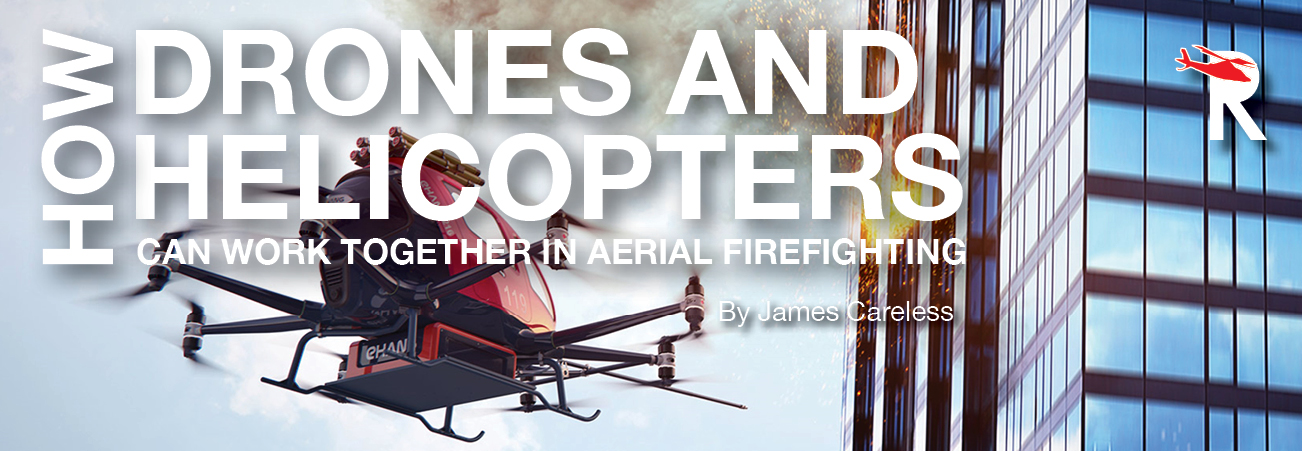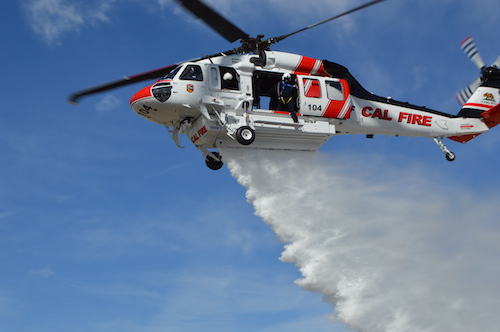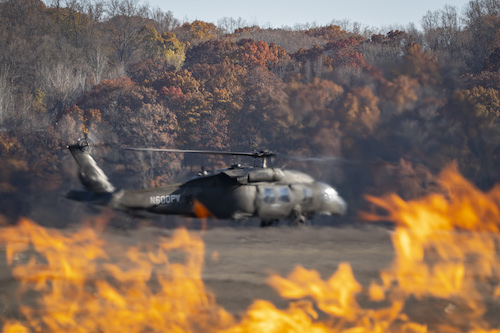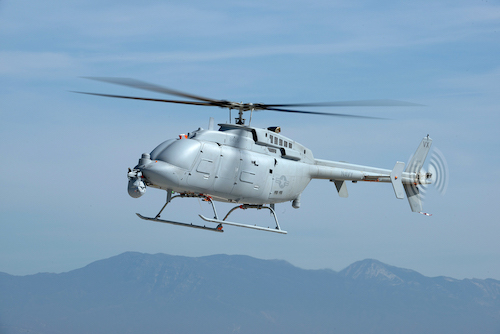|
Mar
26
2024
|
|
Posted 1 years 284 days ago ago by Admin
|
|

Imagine: Sometime in the near future, a combined team of drones and helicopters is dispatched to battle a major forest fire. The drones fan out to identify hot spots, locate survivors, and spray fire suppressants in key areas. The helicopters follow to pick up survivors, apply larger amounts of fire suppressants, and either manage the drones in the air or just coordinate with them due to the drones’ autonomous/ground-controlled flight systems.
This may sound like something out of a science-fiction novel. But it is actually a reasonable projection of where rotorcraft technology is headed in the not-so-distant future. Here’s where we stand right now…
Drones Are Catching Up
When it comes to aerial firefighting, helicopters are well out in front, but drones are catching up.
Let’s start with helicopters, whose ability to fight fires is being backed by major manufacturers. For instance, “Airbus Helicopters has several rotorcraft models active in firefighting missions both here in North America and across the globe including the H125, H145, H215 and H225,” said Jeff Donahue, Airbus Utility Sales Manager. “Many of these aircraft are multi-mission platforms that conduct water dropping, firefighter insertion and pickup, rappelling, aerial ignition, and command and control.”
Meanwhile, “the all-new Subaru Bell 412EPX was heavily designed with aerial firefighting needs in mind,” said Terry Miyauchi, Bell public safety segment manager. “This includes an external load payload jump of 1,100 pounds, now at 12,200, a cargo hook capacity increase to 5,000 pounds and a new transmission with a 30-minute dry certification.”
A Leonardo company spokesperson says, “Leonardo offers a wide range of helicopters in support of these missions. A recent example is the AW139 operated by Italy's National Fire Corps, which entered service not only to perform firefighting missions, but also maritime and mountain search and rescue, medical aid, and civil protection. The AW189 is also proving to be a great success for firefighting missions, especially in Asia, where the Malaysian fire department and the fire service in Seoul and the Tokyo Fire Department are operating their AW189 helicopters.”
Then there’s United Rotorcraft, an Air Methods Division. “United Rotorcraft is the exclusive provider of the Firehawk aerial firefighting system for new Sikorsky S-70i/M Black Hawks, as well as legacy HH/UH-60L model Black Hawks,” said Michael Williams, the company’s senior director of strategy and marketing. “ The fleet now consists of 22 aircraft in active duty: 17 based on the S-70, and three converted HH-60Ls. While the current fleet of Firehawks operate in California, the State of Colorado's first S-70M Firehawk is coming online in 2024 and a second aircraft is on order.”

What about firefighting drones? One of the most compelling contenders in this category is the EHang EH216-S, one of the EH216 series of uncrewed rotorcraft. “Based on EHang’s flagship product EH216-S, EHang launched the Intelligent Aerial Firefighting Solution and the firefighting version EH216-F in July 2020,” said an EHang spokesperson. “The EH216-F is equipped with customized fire-fighting devices, such as fire extinguishing projectiles and launchers, a fire-fighting foam tank and a high-pressure nozzle. It is capable of flying up to 600 meters height to distinguish high-rise fires accurately and efficiently, while traditional rescue ladders and fire nozzles cannot reach the height.”
UAV Navigation-Grupo Oesía produces flight-control systems for rotary- and fixed-wing drones. According to Miguel Ángel de Frutos, the company’s director and CTO, there is a growing demand for firefighting drones. “Fueled by the impacts of climate change, which have heightened the risk and scale of wildfires due to warmer and drier conditions, there is a growing demand for enhanced and adaptable firefighting techniques,” he explained. “As costs decrease and technology advances, the widespread integration of UAVs in firefighting and emergency response is becoming standard practice. Their ease of deployment, operational versatility, and real-time information provision make them an invaluable asset in addressing the escalating threat of wildfires.”
Of course, one way to get the best of both worlds is by adapting high capacity helicopters to fly drone-like firefighting missions. This is what Sikorsky and Rain did in 2023 by equipping an uncrewed Sikorsky Black Hawk helicopter controlled by that company’s Matrix autonomous flight system with Rain's Wildfire Mission Autonomy System. This system is connected to early wildfire detection networks, and uses that data to dispatch assistance as soon as possible. In this instance, the two worked together to execute a precision water drop from a Bambi bucket in December 2023 at Sikorsky HQ in Stratford, Connecticut.

"By combining Sikorsky's Matrix aircraft autonomy system with Rain's early response capability, we have shown the potential to put out a wildfire in its initial stage before it becomes a huge problem," said Igor Cherepinsky, director of Sikorsky Innovations. "Ultimately, Rain envisions equipping fire agencies with the capability to strategically position a future fleet of firefighting helicopters capable of receiving and carrying out mission commands autonomously to suppress a wildfire in its earliest stage," said Rain CEO Maxwell Brodie.
The Power of MUM-T
The notion of drones and helicopters working together is not new. In fact, this magazine (and this writer) raised the idea in an article titled “Manned and Unmanned Teaming in SAR: An Idea Whose Time Has Come” in the October 2021 issue,. The acronym for this concept is “MUM-T” aka Manned-Unmanned Teaming.
“In the realm of aerial firefighting, one of the most significant advancements is the evolution of MUM-T,” de Frutos said. “This concept presents clear advantages by enabling efficient, in-flight coordination and cooperation between manned and unmanned aircraft. For example, a manned aircraft can request specific actions from unmanned systems that provide valuable information while mitigating risk, such as exploring areas of low visibility or coordinating the search for a lost firefighting team.”
It is the ability of drones to serve as ‘eyes in the sky’ that maximizes their value to firefighting helicopters in the air and crews on the ground. “The ability to maneuver drones to fire hotspots has empowered crews to combat blazes more effectively,” said de Frutos. “The revolutionary inclusion of thermal cameras provides firefighters with the crucial ability to see through smoke and monitor hotspots. Furthermore, UAVs exhibit high energy efficiency, a crucial aspect for managing large fires that require prolonged operations. This efficiency positions them as an eco-friendly technology, contributing to a lower carbon footprint in firefighting efforts.”

Since most drones today tend to be small, their usefulness tends to be limited to visual surveillance. But as they grow larger in size — an envelope already being pushed by EHang and Sikorsky — their range of capabilities also expands. A case in point: “A cutting-edge application currently under active investigation is the utilization of large UAS equipped with the capability to transport hydrants for direct fire extinguishment,” de Frutos said. “This innovation poses a significant technological challenge due to the complexity of such missions, involving water loading in intricate locations, low-altitude flight in challenging operational environments (including the presence of other aerial vehicles and aggressive thermals), and precise liquid deployment over targeted areas. These systems are being evaluated for use in scenarios where manned operations are not feasible, such as during nighttime firefighting operations.”
As for team operations? According to EHang, this company’s autopilot and centralized management technologies allow a fleet of EH216-F eVTOLs to be dispatched remotely for first response, even before the firefighters arrive. “Efforts are underway to optimize the seamless collaboration and integration between manned and unmanned aerial firefighting platforms, with the ultimate goal of transitioning to an unmanned mode,” said the EHang spokesperson. “Moreover in urban areas, smaller unmanned rotorcraft firefighting platforms are especially advantageous due to their ability to access tight spaces and maneuver around buildings. This enables them to respond promptly and effectively to fires in densely populated areas where larger manned aircraft may encounter limitations.”
Challenges along the Way
The concept of MUM-T is doable. One proof of its feasibility occurred back in May 2022 when an unmanned (developed from a manned Bell 407 helicopter) flew situational awareness missions with a Sikorsky MH-60S Seahawk from the USS Jackson (LCS-6) in the South China Sea.
“We had a lot of success with the Fire Scout…pushing relay distances out in excess of 100 miles, which is great news,” said Cmdr. Michael Winslow, commanding officer of Jackson’s Blue crew, during a 19 October 2022 press call reported by defensedaily.com.

This being said, the kind of safe firefighting MUM-T imagined in this article requires a higher level of flight coordination. “Key to this development is not only the communication architectures and decision-making capabilities of autonomous systems but also the advancement of Human-Machine Interfaces,” de Frutos said. “These interfaces are crucial in ensuring that humans can fully comprehend and easily operate all aspects of unmanned assets. They facilitate seamless integration, allowing for real-time decision making and enhanced situational awareness.”
“Interconnectivity is key to successful firefighting missions, as helicopters are just one part of the equation,” agreed Airbus’ Donahue. “Clear communication is needed between helicopters and others in the air, including drones and fixed-wing aircraft, as well as between helicopters and those on the ground.”
It’s not just technology that has to advance to enable complex MUM-T firefighting operations. “The implementation of innovative technologies requires a creative regulatory framework and support from local governments to guide operations and enhance performance,” said the EHang spokesperson. In this company’s home country of China, the Ministry of Emergency Management and the Ministry of Industry and Information Technology have responded to this need by jointly issuing “Guidelines on Accelerating the Development of Emergency Robotics.” “The guidelines aim to enhance the unmanned and intelligent level of emergency management,” the EHang spokesperson said.
All this being said, the current use of ground-controlled drones as ‘eyes in the sky’ is enhancing the ability of firefighting helicopters to execute their missions, resulting in a basic form of MUM-T that is delivering results today. In this context, “MUM-T in firefighting enhances operational effectiveness, allowing manned vehicles to leverage the strengths of unmanned systems, such as their ability to operate in adverse weather conditions and provide real-time thermal imaging,” said de Frutos. “This teaming approach enriches the commanders' strategic options and improves overall fire containment strategies, providing a safer, more efficient, and more effective response to wildfire emergencies.”
READ MORE ROTOR PRO: https://justhelicopters.com/Magazine
WATCH ROTOR PRO YOUTUBE CHANNEL: https://buff.ly/3Md0T3y
You can also find us on
Instagram - https://www.instagram.com/rotorpro1
Facebook - https://www.facebook.com/rotorpro1
Twitter - https://twitter.com/justhelicopters